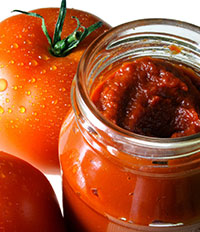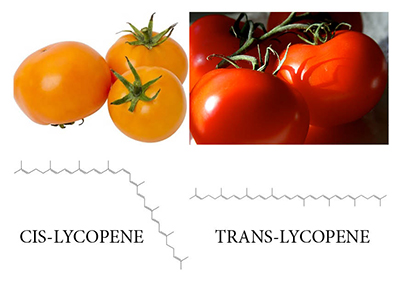http://www.aicr.org/cancer-research-update/2015/10_14/cru_Heat-Shape-and-Type-Increasing-Lycopene-Absorption.html
Heat, Shape and Type: Increasing Lycopene Absorption
This article appears in the October 14, 2015 issue of AICR's Cancer Research Update.

When looking at tomatoes and cancer risk, much of the research focuses on lycopene.
We get about 85 percent of the lycopene in our diets from tomatoes and tomato products, according to the National Institutes of Health. Lycopene is an antioxidant that belongs to a large family of phytochemicals called carotenoids, which also includes the familiar beta-carotene and lutein. Lycopene gives tomatoes, watermelon and papaya their signature red color and there is continuing research on whether foods containing lycopene protect against prostate and other tumors.
Eating a raw tomato provides plenty of lycopene, along with other phytochemicals and nutrients, such as fiber. It also is a part of a cancer-protective eating pattern. But to get the most lycopene in every bite, research is uncovering ways to do that, shares Steven Schwartz, PhD, a food scientist at Ohio State University who specializes in lycopene absorption and it’s role in reducing cancer risk. Currently, with AICR support, Schwartz is helping to investigate what levels and types of lycopene affect prostate cancer risk in mice.
 Shape
Shape
The shape of lycopene appears to be important to absorption. Lycopene is fat soluble and so needs some fats for the body to absorb it more readily. In red tomatoes, nearly all the lycopene exists as a straight (trans) structure. Yet in the body, most of the lycopene molecules are in a bent form, called cis isomers.
Schwartz has demonstrated in his research that processing red tomatoes with oil and high heat for an extended period of time (260°F for 40 minutes) can change the shape of some of the lycopene from trans to cis. In one study he found that when people consumed this cis-lycopene-rich tomato sauce it results in a 55 percent increase in lycopene absorption compared to the trans-lycopene-rich sauce.
Schwartz, along with other researchers, has found that the straight trans-lycopene molecules form crystals that are not easily absorbed into the blood. These molecules may have to be solubilized with fats during digestion in order to be more bioavailable. Yet the bent cis-molecules are less likely to crystallize, which makes them open to solubilize with fats and more efficiently absorbed into the blood, says Schwartz.
Each lycopene-containing food has different amounts of trans or cis lycopene. As opposed to the red tomato, the tangerine tomatoes have about 95 percent of their lycopene in the bent, cis form. Schwartz and his team recently published results of a study demonstrating that compared to traditional red tomatoes, participants who ate tangerine tomatoes absorbed approximately 8 times more lycopene.
Heat and Fat
Regardless of the molecule's shape, cooking tomatoes can help make lycopene more bioavailable, meaning it can easily be taken up into the body’s cells. Lycopene is stored inside the cells and heat breaks down the cell walls. This releases lycopene and other carotenoids, allowing them to be more easily absorbed by the body, explains Schwartz.
 And tomatoes cooked for a long time with added fat, says Schwartz, such as in tomato sauce, contain rich sources of bioavailable lycopene,
And tomatoes cooked for a long time with added fat, says Schwartz, such as in tomato sauce, contain rich sources of bioavailable lycopene,
More important than molecule shape, according to Schwartz, is the co-consumption of fat. “If you don’t have that lipid present, then carotenoids are not efficiently absorbed and can be passed right through the intestine.” Although the exact ratio of lycopene to fat is unknown, Schwartz explains that it must be consumed at the same meal.
“For example, when you have a salad with tomatoes… if you use a full fat salad dressing, we know that will dramatically effect the absorption of carotenoids relative to say a dressing that has no fat. Sometimes, as much as five-to seven-fold. It’s really amazing.”
Lycopene, tomato and prostate cancer risk
Consuming high amounts of foods containing lycopene is currently under study for its role in lowering prostate cancer risk, along with several other cancers. AICR’s latest Continuous Update Project report on prostate cancer found the evidence was too inconsistent to make a conclusion. Further research is underway.
Visit our updated Foods That Fight Cancer: Tomatoes for more on the emerging research related to foods high in lycopene and cancer risk.
Sources:
- Unlu, NZ; et al., Lycopene from heat-induced cis-isomer-rich tomato sauce is more bioavailable than from all-trans-rich tomato sauce in human subjects. British Journal of Nutrition, 2007; 98: p. 140–146
- Cooperstone, JL; et al. Enhanced bioavailability of lycopene when consumed as cis-isomers from tangerine compared to red tomato juice, a randomized, cross-over clinical trial. Molecular Nutrition and Food Research, 2015; 59(4): p. 658-69.
- Unlu, NZ; Bohn, T; Clinton, SK; Schwartz, SJ. Carotenoid absorption from salad and salsa by humans is enhanced by the addition of avocado or avocado oil. The Journal of Nutrition, 2005;135(3): p. 431-6.
- World Cancer Research Fund International. Diet, Nutrition, Physical Activity and Prostate Cancer. November 2014.